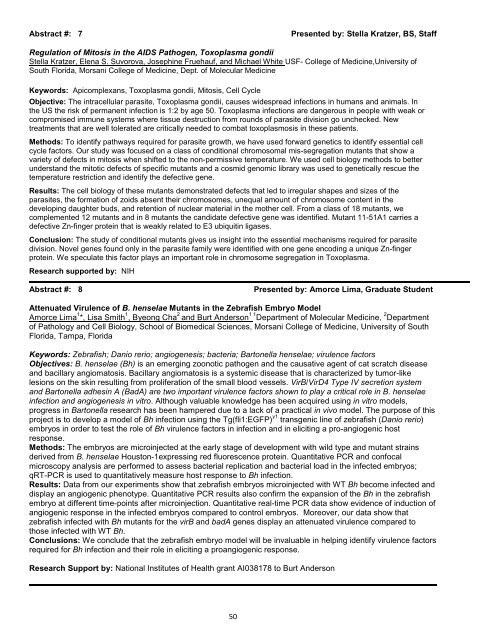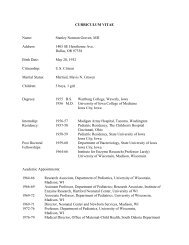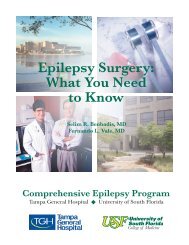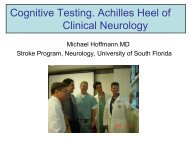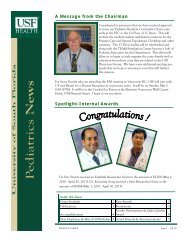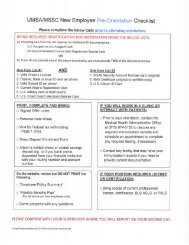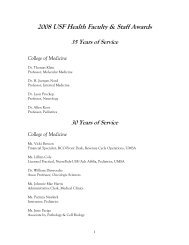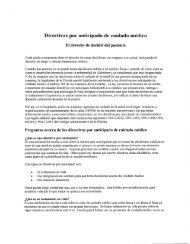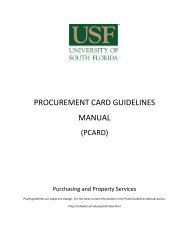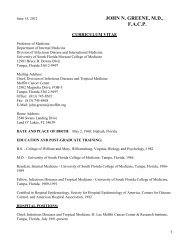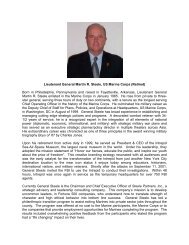2012 USF Health Research Day Virtual Book
2012 USF Health Research Day Virtual Book
2012 USF Health Research Day Virtual Book
You also want an ePaper? Increase the reach of your titles
YUMPU automatically turns print PDFs into web optimized ePapers that Google loves.
Abstract #: 7 Presented by: Stella Kratzer, BS, Staff<br />
Regulation of Mitosis in the AIDS Pathogen, Toxoplasma gondii<br />
Stella Kratzer, Elena S. Suvorova, Josephine Fruehauf, and Michael White <strong>USF</strong>- College of Medicine,University of<br />
South Florida, Morsani College of Medicine, Dept. of Molecular Medicine<br />
Keywords: Apicomplexans, Toxoplasma gondii, Mitosis, Cell Cycle<br />
Objective: The intracellular parasite, Toxoplasma gondii, causes widespread infections in humans and animals. In<br />
the US the risk of permanent infection is 1:2 by age 50. Toxoplasma infections are dangerous in people with weak or<br />
compromised immune systems where tissue destruction from rounds of parasite division go unchecked. New<br />
treatments that are well tolerated are critically needed to combat toxoplasmosis in these patients.<br />
Methods: To identify pathways required for parasite growth, we have used forward genetics to identify essential cell<br />
cycle factors. Our study was focused on a class of conditional chromosomal mis-segregation mutants that show a<br />
variety of defects in mitosis when shifted to the non-permissive temperature. We used cell biology methods to better<br />
understand the mitotic defects of specific mutants and a cosmid genomic library was used to genetically rescue the<br />
temperature restriction and identify the defective gene.<br />
Results: The cell biology of these mutants demonstrated defects that led to irregular shapes and sizes of the<br />
parasites, the formation of zoids absent their chromosomes, unequal amount of chromosome content in the<br />
developing daughter buds, and retention of nuclear material in the mother cell. From a class of 18 mutants, we<br />
complemented 12 mutants and in 8 mutants the candidate defective gene was identified. Mutant 11-51A1 carries a<br />
defective Zn-finger protein that is weakly related to E3 ubiquitin ligases.<br />
Conclusion: The study of conditional mutants gives us insight into the essential mechanisms required for parasite<br />
division. Novel genes found only in the parasite family were identified with one gene encoding a unique Zn-finger<br />
protein. We speculate this factor plays an important role in chromosome segregation in Toxoplasma.<br />
<strong>Research</strong> supported by: NIH<br />
Abstract #: 8 Presented by: Amorce Lima, Graduate Student<br />
Attenuated Virulence of B. henselae Mutants in the Zebrafish Embryo Model<br />
Amorce Lima 1 *, Lisa Smith 1 , Byeong Cha 2 and Burt Anderson 1 1 Department of Molecular Medicine, 2 Department<br />
of Pathology and Cell Biology, School of Biomedical Sciences, Morsani College of Medicine, University of South<br />
Florida, Tampa, Florida<br />
Keywords: Zebrafish; Danio rerio; angiogenesis; bacteria; Bartonella henselae; virulence factors<br />
Objectives: B. henselae (Bh) is an emerging zoonotic pathogen and the causative agent of cat scratch disease<br />
and bacillary angiomatosis. Bacillary angiomatosis is a systemic disease that is characterized by tumor-like<br />
lesions on the skin resulting from proliferation of the small blood vessels. VirB/VirD4 Type IV secretion system<br />
and Bartonella adhesin A (BadA) are two important virulence factors shown to play a critical role in B. henselae<br />
infection and angiogenesis in vitro. Although valuable knowledge has been acquired using in vitro models,<br />
progress in Bartonella research has been hampered due to a lack of a practical in vivo model. The purpose of this<br />
project is to develop a model of Bh infection using the Tg(fli1:EGFP) y1 transgenic line of zebrafish (Danio rerio)<br />
embryos in order to test the role of Bh virulence factors in infection and in eliciting a pro-angiogenic host<br />
response.<br />
Methods: The embryos are microinjected at the early stage of development with wild type and mutant strains<br />
derived from B. henselae Houston-1expressing red fluorescence protein. Quantitative PCR and confocal<br />
microscopy analysis are performed to assess bacterial replication and bacterial load in the infected embryos;<br />
qRT-PCR is used to quantitatively measure host response to Bh infection.<br />
Results: Data from our experiments show that zebrafish embryos microinjected with WT Bh become infected and<br />
display an angiogenic phenotype. Quantitative PCR results also confirm the expansion of the Bh in the zebrafish<br />
embryo at different time-points after microinjection. Quantitative real-time PCR data show evidence of induction of<br />
angiogenic response in the infected embryos compared to control embryos. Moreover, our data show that<br />
zebrafish infected with Bh mutants for the virB and badA genes display an attenuated virulence compared to<br />
those infected with WT Bh.<br />
Conclusions: We conclude that the zebrafish embryo model will be invaluable in helping identify virulence factors<br />
required for Bh infection and their role in eliciting a proangiogenic response.<br />
<strong>Research</strong> Support by: National Institutes of <strong>Health</strong> grant AI038178 to Burt Anderson<br />
50


